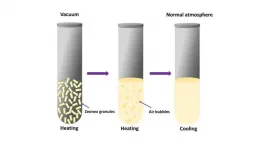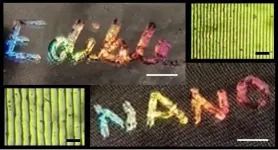Online tool helps estimate COVID's true toll on sub-Saharan Africa
2021-02-17
(Press-News.org) One early feature of reporting on the coronavirus pandemic was the perception that sub-Saharan Africa was largely being spared the skyrocketing infection and death rates that were disrupting nations around the world.
While still seemingly mild, the true toll of the novel coronavirus, SARS-CoV-2, on the countries of sub-Saharan Africa may be obscured by a tremendous variability in risk factors combined with surveillance challenges, according to a study published in the journal Nature Medicine by an international team led by Princeton University researchers and supported by Princeton's High Meadows Environmental Institute (HMEI).
"Although reports of the toll of SARS-CoV-2 in sub-Saharan Africa have to date been generally low in comparison to other regions, we must account for the extreme national and subnational variability in drivers of the pandemic across this region," said first author Benjamin Rice, a Presidential Postdoctoral Research Fellow in ecology and evolutionary biology at Princeton.
Precise projections for sub-Saharan African countries remain difficult given a lack of information on the prevalence of risk factors such as chronic diseases and access to healthcare, Rice said. But he and his co-authors synthesized a wide range of information on risk factors and trends in infection for sub-Saharan Africa from Feb. 25 to Dec. 20, 2020.
The researchers then developed an interactive online tool that shows the impact that different risk factors -- such as rates of chronic disease, the local population density of physicians, and the percentage of an urban population living in crowded housing -- might have on the trajectory of the pandemic.
The researchers also developed a set of simulations to evaluate the role of different drivers of viral spread. Their results showed that climatic variation between sub-Saharan African population centers had little effect on early outbreak trajectories.
That finding is consistent with research that Rice's co-authors Rachel Baker, an associate research scholar in HMEI, and C. Jessica Metcalf, a Princeton associate professor of ecology and evolutionary biology and public affairs and associated faculty in HMEI, have published suggesting that climate conditions in the summer and winter would have a minimal effect on coronavirus during the pandemic phase. Baker, Metcalf and many of the current study's authors are affiliated with the HMEI Climate Change and Infectious Disease initiative.
The Nature Medicine paper also found that differences in connectivity, although rarely considered, are likely an important contributor to differences in how the virus has spread across sub-Saharan Africa, said co-author Fidisoa Rasambainarivo, an HMEI postdoctoral research associate based in Madagascar.
"These results could allow officials to anticipate what might happen in their countries given the varying contexts of human-movement networks and health across sub-Saharan Africa," Rasambainarivo said.
The researchers developed national and sub-national analyses that indicated specific settings where strengthening coronavirus surveillance could yield the greatest returns, Metcalf said. An urgent focus in sub-Saharan Africa is developing a better understanding of the intersection between the pace of the epidemic and the likelihood of disruptions to local and national health systems, which in many areas are already fragile.
"These results underscore the importance of developing tools such as serology to better measure susceptibility in order to directly evaluate the current situation and landscape of risk," Metcalf said.
INFORMATION:
Additional Princeton authors on the paper include postdoctoral research associate Marjolein Bruijning and Ph.D. candidates Malavika Rajeev and Ian Miller, all in the Department of Ecology and Evolutionary Biology.
The paper also included authors from the University of Antananarivo and the University of Fianarantsoa in Madagascar, the Johns Hopkins University School of Medicine, the
University of Southampton, the Research Institute for Development and the University of Paris,
Stellenbosch University in South Africa, and the University of Wisconsin-Madison.
The paper, "Variation in SARS-CoV-2 outbreaks across sub-Saharan Africa" was published online Feb. 2 by Nature Medicine. This work was supported by the Cooperative Institute for Modelling the Earth System (CIMES), the High Meadows Environmental Institute (HMEI), and the Princeton Institute for International and Regional Studies (PIIRS).
ELSE PRESS RELEASES FROM THIS DATE:
2021-02-17
Adequate spacing between births can help to alleviate the likelihood of stunting in children, according to a new study from the Tata-Cornell Institute for Agriculture and Nutrition (TCI).
In an article published in the Proceedings of the National Academy of Sciences of the United States of America, TCI postdoctoral associate Sunaina Dhingra and Director Prabhu Pingali find that differences in height between firstborn and later-born children may be due to inadequate time between births. When children are born at least three years after their older siblings, the height gap between them disappears.
India's family planning policies have focused on lowering population growth and postponing pregnancy to improve maternal health outcomes. But while the overall fertility rate has fallen as low ...
2021-02-17
WASHINGTON -- Researchers have developed an extremely sensitive miniaturized optical fiber sensor that could one day be used to measure small pressure changes in the body.
"Our new pressure sensor was designed for medical applications and overcomes many of the issues of using silica-based fibers," said research team leader Hwa-Yaw Tam from The Hong Kong Polytechnic University. "It is sensitive enough to measure pressure inside lungs while breathing, which changes by just a few kilopascals."
The researchers describe their new optical fiber sensor in The ...
2021-02-17
A new X-ray imaging scanner to help surgeons performing breast tumour removal surgery has been developed by UCL experts.
Most breast cancer operations are what are known as conserving surgeries, which remove the cancerous tumour rather than the whole breast. Second operations are often required if the margins (edges) of the extracted tissue are found to not be clear of cancer.
Researchers at UCL, Queen Mary University of London, Barts Health NHS Trust and Nikon used a new approach to x-ray imaging which allows surgeons to assess extracted tissue intraoperatively, or during the initial surgery, giving 2.5 times better detection of diseased tissue in the margins than with standard ...
2021-02-17
Polyisobutenyl succinic anhydrides (PIBSAs) are important for the auto industry because of their wide use in lubricant and fuel formulations. Their synthesis, however, requires high temperatures and, therefore, higher cost.
Adding a Lewis acid--a substance that can accept a pair of electrons--as a catalyst makes the PIBSA formation more efficient. But which Lewis acid? Despite the importance of PIBSAs in the industrial space, an easy way to screen these catalysts and predict their performance hasn't yet been developed.
New research led by the Computer-Aided Nano and Energy Lab (CANELa) at the University of Pittsburgh Swanson School of Engineering, in collaboration with the ...
2021-02-17
Wearable sleep tracking devices - from Fitbit to Apple Watch to never-heard-of brands stashed away in the electronics clearance bin - have infiltrated the market at a rapid pace in recent years.
And like any consumer products, not all sleep trackers are created equal, according to West Virginia University neuroscientists.
Prompted by a lack of independent, third-party evaluations of these devices, a research team led by Joshua Hagen, director of the Human Performance Innovation Center at the WVU Rockefeller Neuroscience Institute, tested the efficacy of eight commercial sleep trackers.
Fitbit and Oura came out on top in measuring total sleep time, total wake ...
2021-02-17
SAN ANTONIO -- Patients should be assessed for frailty before having many types of surgery, even if the surgery is considered low risk, a review of two national patient databases shows.
Frailty is a clinical syndrome marked by slow walking speed, weak grip, poor balance, exhaustion and low physical activity. It is an important risk factor for death after surgery, although the association between frailty and mortality across surgical specialties is not well understood.
The study, conducted by faculty at multiple institutions including The University of Texas Health Science Center at San Antonio (UT Health San Antonio), mined patient data from the Veterans Affairs (VA) Surgical Quality Improvement Program and the American College of Surgeons (ACS) National Surgical Quality ...
2021-02-17
The millions of people affected by 2020's record-breaking and deadly fires can attest to the fact that wildfire hazards are increasing across western North America.
Both climate change and forest management have been blamed, but the relative influence of these drivers is still heavily debated. The results of a recent study show that in some ecosystems, human-caused climate change is the predominant factor; in other places, the trend can also be attributed to a century of fire suppression that has produced dense, unhealthy forests.
Over the past decade, fire scientists have made major progress in understanding climate-fire relationships at large scales, such as across western North America. But a new paper published in the journal Environmental Research ...
2021-02-17
ROCHESTER, Minn. -- Mayo Clinic researchers have developed a novel proton therapy technique to more specifically target cancer cells that resist other forms of treatment. The technique is called LEAP, an acronym for "biologically enhanced particle therapy." The findings are published today in Cancer Research, the journal of the American Association for Cancer Research.
"The human body receives tens of thousands of DNA lesions per day from a variety of internal and external sources," says Robert Mutter, M.D., a radiation oncologist at Mayo Clinic and co-principal investigator of the study." Therefore, cells have evolved complex repair pathways to efficiently repair damaged DNA. Defects in these repair pathways ...
2021-02-17
With the seemingly unstoppable advancement in the fields of miniaturization and materials science, all sorts of electronic devices have emerged to help us lead easier and healthier lives. Wearable sensors fall in this category, and they have received much attention lately as useful tools to monitor a person's health in real time. Many such sensors operate by quantifying biomarkers, that is, measurable indicators that reflect one's health condition. Widely used biomarkers are heartrate and body temperature, which can be monitored continuously with relative ease. On the contrary, ...
2021-02-17
Holograms are everywhere, from driver's licenses to credit cards to product packaging. And now, edible holograms could someday enhance foods. Researchers reporting in ACS Nano have developed a laser-based method to print nanostructured holograms on dried corn syrup films. The edible holograms could also be used to ensure food safety, label a product or indicate sugar content, the researchers say.
Most holograms are imprinted with lasers onto metal surfaces, such as aluminum, but the materials aren't edible. For foods, holograms made with nanoparticles have been proposed, but the tiny particles can generate reactive oxygen species, which might be harmful for people to eat. In a different approach, food scientists have ...
LAST 30 PRESS RELEASES:
[Press-News.org] Online tool helps estimate COVID's true toll on sub-Saharan Africa





